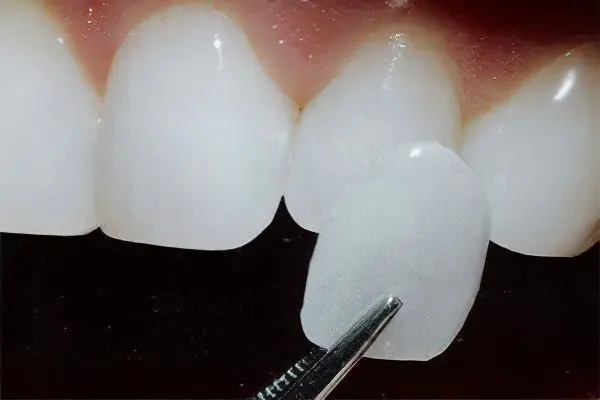
Veneers are ceramic or composite micro-prostheses that are installed on the front surface of the teeth that fall into the smile zone. Veneers give the front teeth an even, attractive appearance, the desired color and shape.
Veneers differ from crowns in that they do not completely cover the teeth, but only their frontal part and cutting edge. Most often, a microprosthesis is installed on 8 lower and 10 upper teeth.
The thickness of this type of microprosthesis does not exceed 0,6 mm. To visualize this thickness, you can take an eggshell and look at it. So the veneers will be about twice as thick. Although there are even thinner varieties of veneers – these are lumineers (up to 0,1 mm).
The appearance of the dentition after the installation of veneers on them improves significantly, the teeth acquire the desired shape, color and strength. Modern dentistry makes prostheses that will be simply impossible to visually distinguish from your own teeth. However, the pros and cons of veneers installed on teeth are very contradictory, so you should familiarize yourself with them before deciding on the procedure.
Types of veneers on teeth
There are two types of materials from which veneers are made: ceramic and composite:
Ceramic veneers. Porcelain veneers are usually distinguished into porcelain and zirconium. You can also come across names such as indirect veneers or orthopedic veneers. The fact is that this type of microprosthesis is made by an orthopedic dentist, and not a dentist-therapist. To create a prosthesis, you will need a dental laboratory. Only after a series of corrections and color selections, it will be possible to attach veneers to the teeth.
Porcelain veneers can be made from pressed and unpressed ceramics. For the manufacture of pressed veneers, ceramics are first held under high pressure and then injection molded at high temperatures. This allows you to achieve maximum strength and reliability of the structure.
Unpressed veneers are made from porcelain mass, which is applied in layers and fired. In terms of strength, such veneers are inferior to pressed porcelain microprostheses, but they look more aesthetically pleasing.
Zirconia veneers are characterized by minimal fragility and maximum naturalness. Porcelain is also used for their manufacture, but it is supported by a strong zirconium frame. Zirconium-based veneers are even more reliable than pressed porcelain microprostheses, however, they are less transparent, since their framework is denser.
The choice of material for the manufacture of veneers should be based on the original color of the enamel of your own teeth. If the enamel is dense, then you can opt for any veneers, and if it is transparent, then it is better to choose porcelain microprostheses.
Composite veneers. Even a dentist-therapist can make this kind of micro-prostheses, since they are made right in the patient’s mouth. If we turn to the essence of composite veneers, then they can be called a regular filling, which is located on the front of the lower and upper dentition.
To make high-quality composite veneers, you need a laboratory, and not a regular dental office.
Characteristics of composite veneers:
The aesthetics of composite veneers are far from natural, translucent and lustrous of their ceramic counterparts. In addition, such microprostheses differ in color, transparency and surface quality from the patient’s own teeth.
The color of composite veneers quickly loses its original attractiveness. Over time, the design fades and darkens.
Composite microprostheses are very fragile compared to ceramic veneers, which means they have a lower degree of reliability. This is especially true for the front teeth, because it is with their help that a person bites off food.
The very technique of manufacturing a microprosthesis inside the patient’s mouth should be questionable. After all, it is unlikely that it will be possible to make a high-quality and beautiful dentition in a time limited to 1 hour and 10 minutes.
[Video] Veneers – types, price, installation of veneers for teeth, warranty. Ultraneers, Lumineers, Componeers:









